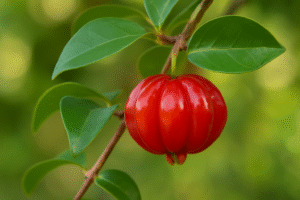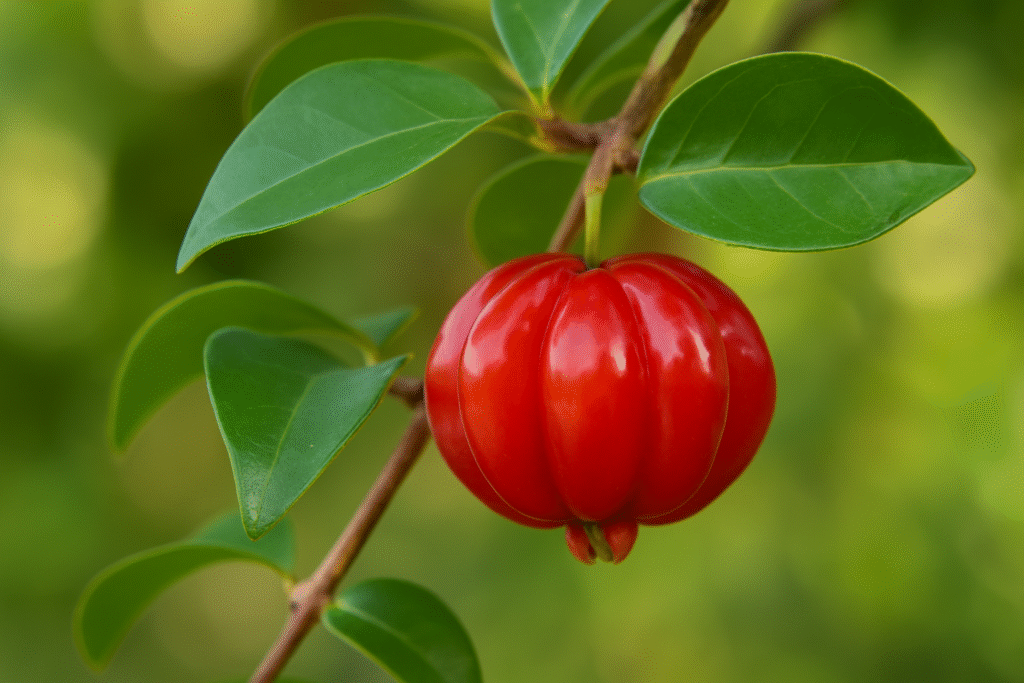The Surinam cherry, known in Brazil as pitanga and scientifically named Eugenia uniflora, is a tropical fruit native to South America, especially abundant in Brazil. Small, brightly colored, and with a sweet-and-tart flavor, the Surinam cherry is a delight for anyone who tastes it for the first time. Its distinctive ribbed shape, resembling a miniature pumpkin, and its culinary versatility make it a unique ingredient for juices, jams, ice creams, and even gourmet dishes.
Despite being plentiful and widely appreciated across Brazil, the Surinam cherry is rarely exported. For those who know its flavor and health benefits, this might be surprising. In this article, we will explore what makes this fruit so special, its nutritional advantages, and the 5 main reasons why it is still hard to find in international markets.
Characteristics of the Surinam Cherry
The Surinam cherry grows on bushes or small trees that can reach between 2 and 4 meters in height. Its leaves are bright green and release a characteristic aroma when crushed. The fruit, usually picked when ripe, can vary in color from deep red to purple, passing through orange shades as it matures.
Its flavor is distinctive: when harvested at the right time, it is sweet with a refreshing tart touch. However, if picked too early or too late, it can have a more astringent taste.
Nutritional Benefits
The Surinam cherry is not only delicious but also highly nutritious. Its main benefits include:
-
Rich in vitamin C – important for strengthening the immune system
-
High in antioxidants – helps fight free radicals and slow premature aging
-
Low in calories – ideal for balanced diets
-
Source of essential minerals – including iron, calcium, and phosphorus
-
Anti-inflammatory properties – aids in reducing internal and external inflammation
It is also rich in anthocyanins, compounds that contribute to cardiovascular health and cell protection.
Culinary Uses
In Brazil, the Surinam cherry is often eaten fresh, straight from the tree, but it is also used to make:
-
Juices and smoothies
-
Jams and preserves
-
Homemade ice creams and popsicles
-
Liqueurs and fermented drinks
-
Sweet-and-sour sauces for meats and poultry
In gourmet cuisine, chefs have been exploring its potential to create tropical, sophisticated dishes, pairing it with seafood, desserts, and exotic salads.
5 Reasons Why the Surinam Cherry Is Rarely Exported from Brazil
Even with all its potential, the Surinam cherry is seldom found in international markets. Here are the main factors that hinder its exportation:
1. Short Shelf Life
The Surinam cherry is extremely delicate and highly perishable. Even when refrigerated, it lasts only a few days, making long-distance transportation challenging without significant loss of quality.
2. Logistical Challenges
Due to its fragility and tendency to bruise easily, the Surinam cherry requires special packaging and constant cold storage during transport. These requirements increase logistical costs, making the fruit less competitive abroad.
3. Limited Large-Scale Production
In Brazil, the Surinam cherry is mostly grown in home gardens or small farms. Large-scale commercial production, with industrial harvesting and grading standards, is still limited, making consistent supply for export difficult.
4. Lack of International Awareness
Outside of South America, the Surinam cherry is not well-known. Without consistent marketing campaigns and consumer education, international demand remains low, discouraging investment in export efforts.
5. Competition from More Established Fruits
In global markets, there are many competitors with longer shelf lives and greater brand recognition, such as strawberries, cherries, and blueberries. These fruits already have well-established supply chains and loyal consumers, making it harder for the Surinam cherry to enter the market.
Future Potential
Despite these challenges, there are ways to bring the Surinam cherry to a global audience. One promising approach is to focus on exporting processed products, such as frozen pulp, jams, liqueurs, and concentrated juices. These have a longer shelf life and retain the fruit’s unique flavor.
The growing global trend toward exotic and healthy foods could also help the Surinam cherry gain recognition abroad. With targeted marketing strategies and partnerships with tropical fruit exporters, Brazil could turn this small treasure into a big success story.
Conclusion
The Surinam cherry (pitanga) is a tropical fruit full of flavor, nutrients, and culinary potential. However, factors like its short shelf life, complex logistics, and lack of large-scale production still limit its presence in global markets.
While we wait for the day when the Surinam cherry becomes a common sight on supermarket shelves worldwide, in Brazil it continues to delight consumers and chefs alike. Investing in creative commercialization strategies could be the key to ensuring that, in the future, this special fruit crosses borders and wins over taste buds around the globe.

Experience Deep Relaxation with Jasmine Bliss
Indulge in the luxurious Blue Nectar Sensuous Jasmine Body Massage Oil, infused with 8 potent herbs and 100% natural essential oils. Perfect for soothing the body, calming the mind, and creating a spa-like massage therapy experience at home.
Inga: Incredible Truths You Need to Know
Explore the fascinating facts about Inga, from its unique characteristics to its role in nature and local traditions. Discover why this tropical plant is valued and the secrets behind its remarkable qualities.

